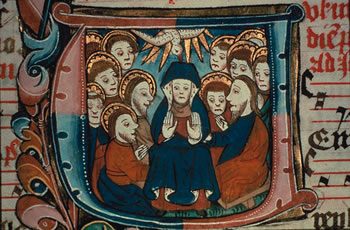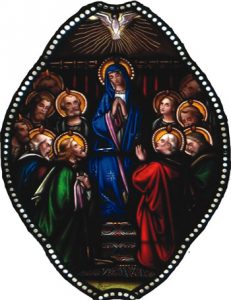Mary for Today – Mary at Pentecost
Pentecost: This feast originally marked the end of the grain harvest. In time it came to be associated with the Exodus and the giving of the covenant. In NT times it took on a new significance as the day in which the Spirit is given to the disciples of Jesus. Eventually the fifty day period, influenced by Luke’s writings, separated into three festivals of Resurrection-Ascension-Pentecost.
Born of the Spirit: The last mention of Mary by Luke occurs at Pentecost and in Acts 1:12-14. Throughout his Gospel and in Acts, Luke uses summary statements. What we know about Mary from his first volume, her image, receives its final summing up in the second volume. Luke considers that what happened in the upper room, at the coming of the Holy Spirit upon the believers, a parallel to his Infancy Narrative. The birth of the Church is the presentation of the power of the Spirit of Jesus upon the apostles, Mary, and the brothers and sisters of Jesus.
The life of Jesus was similarly announced by the power of the Spirit upon the Virgin Mary at the Annunciation (Lk 1:26-38). Both births, of the physical and then the spiritual body of Jesus, occur at the beginning of each of Luke’s major writings and are both under the shadow and power of the Holy Spirit. While the account of the birth of Jesus is told through the lens of the Old Testament birth narratives, the birth of the Church has a different literary pattern. Yet the content and message are the same. 
Mary was told, “The Holy Spirit will come upon you and the power of the Most High will overshadow you; hence the holy offspring to be born of you will be called Son of God” (Lk 1:35). The faithful followers of Jesus are told not to leave Jerusalem for “within a few days you will be baptised with the Holy Spirit” (Acts 1:5). They are to continue the mission of Jesus: “You will receive power when the Holy Spirit comes down upon you; you will be my witnesses in Jerusalem, throughout Judea and Samaria, yes, even to the ends of the earth” (Acts 1:8).
The Place of Prayer: The group gathered in the upper room are the disciples mentioned in Acts 1:2; the eleven named are the apostles; Mary, the mother of Jesus is named, while the women and ‘brethren’ are mentioned. All of them are united in the prayer that was to characterise the emerging Church in Acts. Mary, in Luke’s Gospel, is a model of faith and prayer (see her dialogue with the angel in 1:26-38; her prayer of praise in the Magnificat, and her reflective mind and heart, 2:19 and 2:51). Her presence in the upper room is more than symbolic. Among all the names in Acts 1:13, Mary is the person who has actually given witness to a prayer life modelled on the Psalms and to a personal reflective prayer life.
We know the disciples frequented the temple at the hours of prayer; the temple begins and ends this gospel. Yet we are given the content of Mary’s prayer through her pondering over the events and words spoken of her Son in his early life. She is now a model for the apostles, disciples, and friends of Jesus gathered in the upper room. If later the newly formed twelve continue to devote themselves to prayer and the ministry of the word, then such a movement was significantly enhanced by Mary’s sharing in the inception of the Church. Mary shared in that prayer with them and the gathered ones. Before the descent of the Spirit, prayer united them; after the coming of the Spirit, prayer continued among them and calmed the storms associated with their early mission.
Mary, Model for the Church at Prayer: Clearly Mary is a full member of the group gathered in Acts 1:14. To be ‘of one mind’ and heart means no second class citizens. Mary is fully the Church inasmuch as the Church is at prayer. This is the last mention of her in the New Testament; there is no trace of her being sent out on mission. Prayer too is mission and here Mary is a model par excellence. It was good intuition on the part of the Church that the praying St. Theresa, the Little Flower, was named Patron of Missions and Missionaries. The parallels are clear.
John’s Gospel, which often has similar themes to Luke, was aware of a tradition of Mary’s presence, not at Calvary in a scene unique to John, but at Pentecost when the Christian Church is born. The sign symbolism in John 19:25-28 is suggestive of birth of the Church in blood and water, and the breath of Jesus, his Spirit, as given to the gathered community waiting at the foot of the Cross (Pentecost).
The Pentecost text in Acts gives us the name of Mary and places her in a special position to be representative of the Church at prayer. The woman who emerges in Luke as the best image of the Church is Mary, the mother of Jesus. In the two volume work of Luke-Acts there is a definite pattern of paralleling events from the first book to the second. As Mary was physically the mother of Jesus, so, too, she is actively present as the Church is being born at Pentecost. Through her prayer – a prayer of waiting and expectation of the fulfilment of the promises of the Risen Lord – Mary becomes both a dynamic instrument and consenting human person who disposes herself to receive the gift of the Spirit just as she did at the Annunciation.
A Spirit shared: Now the Holy Spirit impregnates all gathered in the upper room; now they all proclaim and witness to their new birth as the community of the Risen Lord. The all-inclusive universalism of Luke’s vision does not allow him to avoid mentioning Mary, woman of faith and prayer from the Annunciation in Galilee, to the temple rites in Jerusalem, to the time of Passover, and now finally in the upper room awaiting the descent of the Holy Spirit, the promise of Jesus. The age of the Church has at its origins that same believing woman who brought Jesus into our world’s history as God’s agent of salvation.
In his Gospel Luke has nineteen mentions of prayer; in the Acts there are twenty five significant passages. The birth of the Church is presented as a result of prayer, waiting for the promise of the Spirit. In obedience to Jesus they gather in the upper room and were of one mind and one heart steadfast in prayer. Prayer was integral to the Church movement from its start. Mary was a central figure in that initial experience.
Source: Buby, Bertrand S.M. (1994) Mary of Galilee. Vol.1. St Pauls.

 Entries(RSS)
Entries(RSS)